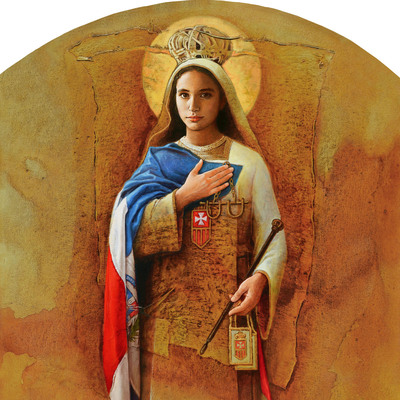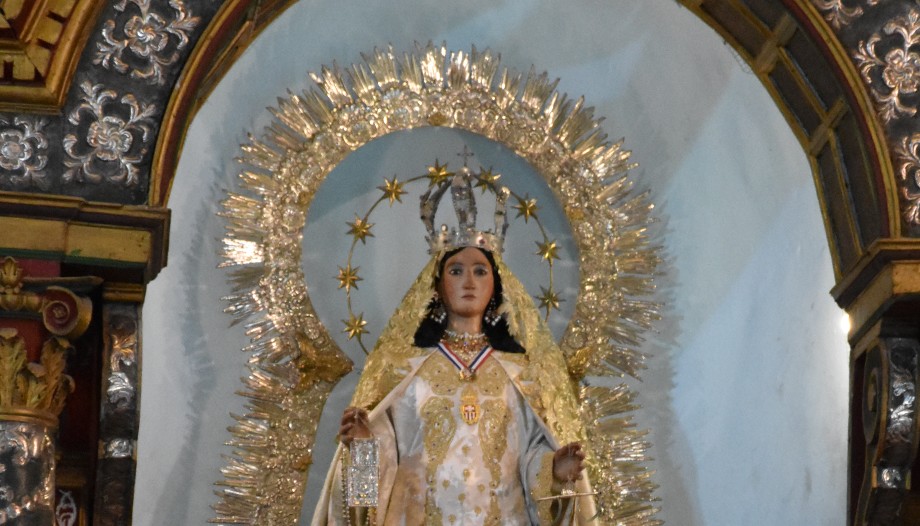Our Lady of Mercy is one of the most beloved devotions of the Dominican Republic. The devotion was born in the 13th century, when the Virgin appeared to two saints and the King of Aragon to ask for the foundation of a religious order dedicated to the rescue of Christians held captive by the Saracens.
In 1494, some Mercedarians traveling with Columbus took a picture of the Virgin of Mercy to America, thus initiating her devotion in the New World.
The history of the invocation
The particular invocation of the Virgin of Mercy has its origin when on August 1, 1218 the Mother of God appeared separately to three illustrious people from Barcelona in her invocation of the Virgin of Mercy: St. Peter Nolasco, who would be the founder of the Order of Mercy, King James I of Aragon and St. Raymond of Peñafort, a Dominican friar. Days later, the three met in the cathedral of Barcelona and shared having had the same apparition of the Virgin. She asked them to found a religious order dedicated to the redemption of captives. Nine days later, the order was founded by St. Peter Nolasco.
Their particular mission was to show mercy to Christians held captive by Muslims and Saracen pirates. Many of its members, known as Mercedarians, exchanged their lives for that of prisoners and slaves, the number of them being estimated at 300,000.
Our Lady travels to America
On September 25, 1493, a large fleet commanded by Columbus, composed of 14 caravels and 3 galleons, left Spain. On board were 1,500 men, including thirteen missionaries led by Father Boíl, among them two Mercedarians: Juan Infante and Juan de Solórzano. Before leaving, the Queen of Spain had given them both a picture of the Virgin of Mercy that would accompany them on their journey to America. It is the first invocation of the Mother of God that traveled to the New World.
They disembarked on January 2, 1494 in a place chosen by Columbus to establish the first Hispanic foundation in America, and on January 6, the day of the Epiphany or manifestation of God to men, the first Eucharist was celebrated in the New World, in which the 13 missionaries participated. Thirteen so that, as in the last supper, one would mystically represent Christ and the others the twelve apostles, a celebration that surely counted with the presence of the picture of the Virgin of Las Mercedes.
El Santo Cerro
Juan Infante, one of the two Mercedarians, was Columbus' confessor, and as such always accompanied him. According to legend, he was also with him when Columbus, in early March 1495, while marauding in the vicinity of the fort of La Concepción de la Vega, from the top of a hill, gazed in ecstasy at the beauty of the valley he had named the Vega Real.
Overwhelmed by the exuberant landscape, he thought of honoring God by placing on the top of the mountain -for the first time in America- a gigantic cross, symbol of the Christian faith. Later, Juan Infante had a rustic chapel built next to it to venerate the Virgin of Las Mercedes. Since then, both devotions - that of the Holy Cross and that of the Virgin of Las Mercedes - have been together in what today is called Santo Cerro.
Columbus and the Virgin of Mercy
The devotion spread throughout the island, turning the hill into a place of pilgrimage, reflection and marked devotion. Columbus himself, in his codicil of August 1505, months before his death, recommended to his son Diego to support a chapel where he would pray for his soul, as if with his already hesitant index finger he pointed to the Holy Hill: "and if this could be on the Island of Hispaniola, which God gave me miraculously, I would be happy if it were there where I invoked it, which is in La Vega, which is called La Concepción".
With the arrival in 1527 of Friar Francisco de Bobadilla, Vicar General of the Mercedarians, and twelve other priests, the Mercedarians spread throughout Santo Cerro, Santiago and Azua, building monasteries in those places, which contributed greatly to the strengthening of the devotion to the Virgin of Mercy throughout the island of Hispaniola.
The earthquake of 1641
During the months of August and September 1641, a strong earthquake shook the city of Santo Domingo. Some chronicles state that strong aftershocks lasted for more than forty days, with a death toll of 24 people. Frightened, the inhabitants of the city went to the image of Our Lady of Mercy that is in the Convent of this Order, and, on the eve of her feast of the Nativity (September 7), they experienced the divine favor and some wonders happened. For this reason, the following year, 1615, the Curia and the Royal Audience declared Our Lady of Mercy patroness of the city and the island, celebrating her feast on September 8 of each year. In 1710, by Royal Decree, her feast day was moved to September 24.
The Battle of the Limonade
On January 21, 1691, the Spanish army of Santo Domingo, under the command of Field Master Don Francisco de Segura y Sandoval, confronted the French in the Sabana Real de la Limonade, a confrontation in which the Creoles were victorious. The combat had been hard-fought, and they invoked Nuestra Señora de Las Mercedes. In the body of the battle there was a canvas with her image, while the soldiers from the eastern part of the island invoked the Virgin of Altagracia, whose action was decisive in the triumph of the Creole arms.
From there, the faith in Nuestra Señora de las Mercedes was strengthened and the cult of the Virgin of Altagracia began throughout the island. The battle took place on January 21, the date on which Altagracia Day is celebrated.
The Virgin and Toussaint
In 1801, Toussaint Louverture invaded Santo Domingo in the name of France. The day after his arrival he attended the cathedral, where there were many faithful praying, and requested the parish priest to place the Host on the virile, kneeling with his hands folded on his chest. His assistants informed him that, while he was doing this, some of the damsels in attendance were smiling sarcastically and, what was worse, informed him that three Creole soldiers had turned their backs so as not to salute him.
Angry, Toussaint ordered that the next day everyone gather in the parade ground with the intention of committing a general beheading.
When the next day arrived and all the inhabitants were assembled, men, women and children separated, surrounded by the cavalry with their drawn sabers, ready to slit their throats, Toussaint approached the ladies and with his baton touched them, asking them: "French or Spanish? When he touches Dominga Núñez, she reproaches him: "Bold, learn some manners!".
Angry, he climbs the stage to order the slaughter. The sky, clear up to that moment, suddenly darkened. Thunder shook the earth and, suddenly, a space opened up in the sky, and a beam of white light appeared. Toussaint, frightened, looked at the light and ordered everyone to withdraw. Asked by his assistants the reason for his attitude, he answered: "It was her, Our Lady! I saw her! I saw her!". The Virgin of Las Mercedes had interceded once again in favor of the Creoles.

Patroness of the Dominican Republic
When the Dominican Republic was proclaimed on February 27, 1844, after the Trinitarians launched into the air the cry of "God, Homeland and Liberty", three exclamations came from those present at that historic moment: "Long live the Dominican Republic! Long live the Virgin! Long live Duarte!". From that moment on, the Virgin of Las Mercedes was instituted as Patroness of the Dominican Republic.
Compiler








